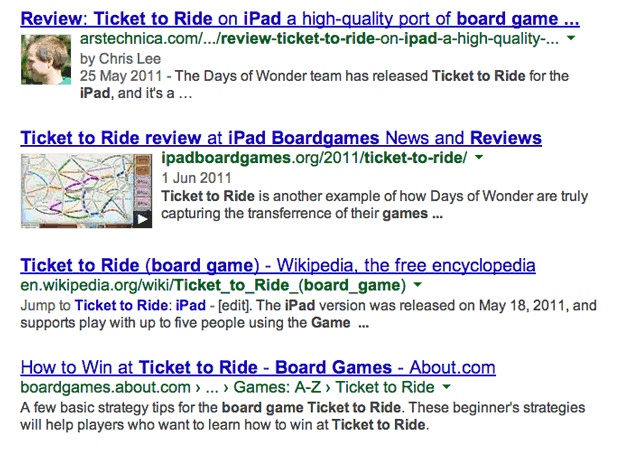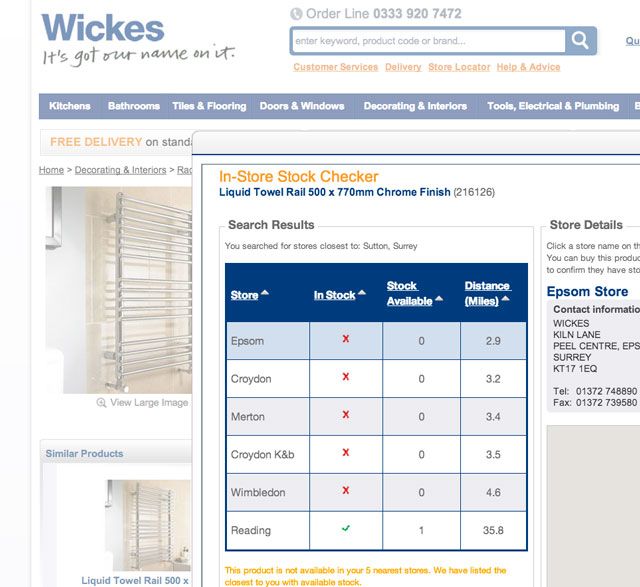Running a successful online shop is hard – there's just so many around nowadays that making yourself stand out from the crowd is incredibly difficult. We all know that the old SEO tricks don't work anymore – it's all about the content – so is all hope lost for eCommerce? Nope! Here are 5 actionable steps you can take to stay ahead of the game in 2014.
Joel wrote about 5 innovative ways to promote your home business, but those were baby steps – today we're racking it up a notch. Buckle up.
Authorship: You’re an expert now
You’re already writing relevant and high quality blog posts about your business – of course you are – but have you established yourself as the author for those? Authorship is an initiative launched by Google a few years back to help quality articles gain more recognition than those written by someone perhaps unknown. The principle is simple: if your name is on something, the article has more credence than "anonymous". Check out the following results - which would you be more likely to click on?
Probably the top result, right? Because not only does it have that additional thumbnail that other results don’t have, but the fact it highlights some strapping young lad as the author who’s identified personally by name probably means it’s more trustworthy than the other ones.
So how do you go about getting those lovely thumbnails next to your posts? Start with a verified Google account with your real name and photo, then follow these instructions. If you're running Wordpress, just install the Yoast Wordpress SEO plugin, and ensure your Google Plus profile is linked from the social tab of the setting page.
Videos, and thumbnails
Authorship is perfect for establishing authority on blog posts, but not so appropriate for actual product pages: videos are so much better. If you’re already making videos of your products for inclusion on the sales page, you could seriously increase your click-through rate in the search results by telling Google about that video – it wants to know, and it’ll reward you with a thumbnail just like this.
That, I think you’ll agree, is a lot more clickable that the other results.
If you’re not already making product videos, consider this suitable motivation to start. Starting an online business is a lot more than simply putting up a website and selling things: you need to add value to those listing so you actually stand out, and videos are one perfect way of doing that. Even if it’s just a simple video of a model twirling around in your dress, that still counts and will get a preview - you'd be taking photos anyway, so might as well make it a video.
How do you get these magical video snippets? That’s a little more complex, but the shortcut if you’re using Wordpress is to host your own videos, and purchase the Yoast Video SEO plugin, an upgrade to the already great Wordpress SEO plugin (both featured on our Best Wordpress Plugins page). It will automatically detect your media, generate the right snippets, and create a video site map for you to submit to Google.
Concentrate on Pinterest
Online marketing often concentrates on Facebook due to sheer number of users, but the problem with getting your customers to share your products on Facebook is that they’re making it increasingly difficult for non-personal updates or those from fan pages to then be seen by other users. That’s great for Facebook users who may only want to read updates form their friends, but it’s not all that great for you. Whoopee–- your product has been shared 100 times! But how many sales actually resulted from that? Not a lot.
Pinterest, on the other hand, puts products and ideas front and centre. There’s no filtering of updates according to complex algorithms: if a user pins your product to their scrapbook, it’s there, and it’s seen by anyone who follows them. Users collate their own scrapbook around on central idea, so chances are that your product is going to be featured among related ideas and topics: not simply a stream of social diarrhoea like Twitter.
The only downside to Pinterest is that the number of users just isn’t at the level of Facebook yet – but that’s ok. Get in there now, get your products on the boards of some early pioneers and in the long run the tactic will pay off. One thing you can be sure of is that conversion to sales from Pinterest is lot more likely than something shared to Facebook or any other social network. I'm living proof: I’ve bought things off Pinterest before, but never off a Facebook recommendation. Pro tip: add keyword rich comments to everything you post – Pinterest is going a great job now of automatically scraping everyone's pins for a particular topic, but they can only do that if you've given them the right hints.
Try kickstarting your Pinterest presence with a Pinterest Scavenger Hunt, like this one organised by CottageLife.
Mobile matters: "Responsive" themes
Fact: on Black Friday 2013, 40% of all online shopping came from mobile devices. Take a look at your shop from your smartphone or tablet – does it even work? Is it so frustrating you’d just leave? Good job: you're throwing away customers!
It’s time for a new theme: look for what’s called "responsive", which means the theme elements will dynamically adjust the size to suit smaller screens or different browser sizes. You can buy ready-made themes for Wordpress that are fully responsive and just waiting for you to customise them with a logo - there is absolutely no need to pay thousands to some "design agency". Either way, you need a responsive theme.
Multichannel selling
The buzzword this year is multichannel or omnichannel selling, which basically means selling your wares somewhere other than just your website. We’re not necessarily talking about physical locations here , but instead things like Google product feeds, eBay, and Amazon. Here's how to get listed on Amazon, and my own tips for selling more on eBay.
If you do also have physical locations, ensure customers can see stock levels at various locations as well as online – give the option to drive out of town and pick something up if it's out of stock online or locally.
I realise you probably don't want to give away all your secrets, but can you share some of your tips for successful eCommerce in 2014?





